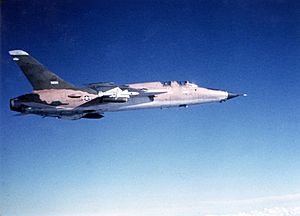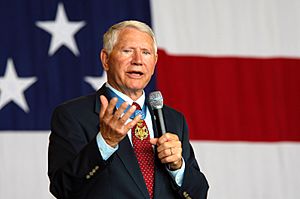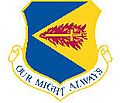Leo K. Thorsness facts for kids
Quick facts for kids
Leo K. Thorsness
|
|
|---|---|

Medal of Honor recipient Colonel Leo K. Thorsness
|
|
| Member of the Washington Senate from the 11th district |
|
| In office January 9, 1989 – January 11, 1993 |
|
| Preceded by | Eugene V. Lux |
| Succeeded by | Margarita Prentice |
| Personal details | |
| Born |
Leo Keith Thorsness
February 14, 1932 Walnut Grove, Minnesota, U.S. |
| Died | May 2, 2017 (aged 85) St. Augustine, Florida, U.S. |
| Resting place | Arlington National Cemetery |
| Political party | Republican |
| Alma mater | South Dakota State College University of Omaha University of Southern California |
| Military service | |
| Allegiance | United States of America |
| Branch/service | |
| Years of service | 1951–1973 |
| Rank | |
| Unit | 357th Tactical Fighter Squadron, 355th Tactical Fighter Wing |
| Battles/wars | Vietnam War |
| Awards | Medal of Honor Silver Star (2) Distinguished Flying Cross (6) Bronze Star (2) Purple Heart (2) Air Medal (10) |
Leo Keith Thorsness (born February 14, 1932 – died May 2, 2017) was a colonel in the United States Air Force. He was awarded the Medal of Honor, the highest military award in the U.S., for his brave actions during an air battle in the Vietnam War on April 19, 1967. Just two weeks later, his plane was shot down, and he became a prisoner of war in North Vietnam for almost six years. After his time in the military, Thorsness served one term as a state senator in Washington.
Contents
Growing Up and Joining the Air Force
Leo Thorsness was born on February 14, 1932, in Walnut Grove, Minnesota. His family lived on a farm there. As a young person, he achieved the rank of Eagle Scout in the Boy Scouts of America. This is a very special achievement, and Thorsness is one of only a few Eagle Scouts who also received the Medal of Honor.
He went to South Dakota State College where he met his future wife, Gaylee Anderson. They got married in 1953 and had a daughter named Dawn.
In 1951, when he was 19, Thorsness joined the Air Force because his brother was fighting in the Korean War. By 1954, he became an officer and a pilot. He later earned two college degrees. He started as a pilot flying different types of jets, including the F-84 and F-100. Later, he became a pilot for the F-105 Thunderchief.
In 1966, Thorsness trained to fly "Wild Weasel" missions. These missions involved finding and destroying enemy surface-to-air missile (SAM) sites in North Vietnam. He was sent to Thailand and flew these missions from Takhli Royal Thai Air Force Base.
A Heroic Mission: The Medal of Honor Story
On April 19, 1967, Major Thorsness and his Electronic Warfare Officer, Captain Harold E. Johnson, were flying an F-105F jet. They were leading a group of planes on a "Wild Weasel" mission to destroy SAM sites near Hanoi, a heavily defended area.
Thorsness bravely flew his plane to draw attention from enemy gunners, while other planes in his group tried to attack. He found two SAM sites. He fired a Shrike missile at one, which stopped its radar. He then destroyed the second site with cluster bombs.
After this success, things got very dangerous. Another plane in his group was hit by anti-aircraft fire, and its two crew members had to eject (parachute out). Meanwhile, enemy MiG-17 fighter jets attacked the other planes in Thorsness's group, forcing them to leave the area. Thorsness was left alone.
As Thorsness circled to help locate the downed crew members, his officer spotted a MiG-17. Even though his F-105 was not designed for air-to-air fighting, Thorsness attacked the MiG and shot it down with his plane's cannon! Another MiG then appeared on his tail. Running low on fuel, Thorsness managed to escape the MiGs and headed to meet a tanker plane for more fuel over Laos.
While he was refueling, a rescue team of A-1E "Sandy" planes arrived to find the downed crew. Thorsness, even though he had very little ammunition left, decided to turn back and protect the rescue planes. As he returned, he saw more MiG-17s. He attacked again, possibly shooting down another MiG.
The MiGs then attacked the rescue planes, shooting down one of them. Thorsness, with no ammunition left, still flew back to the scene. He hoped to draw the MiGs away from the last rescue plane. Luckily, more F-105s from his unit arrived and engaged the MiGs in a dogfight (air battle). This allowed Thorsness to finally leave the area after a 50-minute fight against missiles, anti-aircraft guns, and MiGs.
Later, another F-105 pilot ran critically low on fuel. Thorsness, despite being low on fuel himself, guided the tanker plane to help the other pilot. Thorsness then managed to glide his own plane to a base, landing with almost no fuel left.
This incredible mission was later featured on a TV show called Dogfights on The History Channel.
A Prisoner of War
On April 30, 1967, just two weeks after his heroic mission, Thorsness and Captain Johnson were shot down by a Mikoyan-Gurevich MiG-21 jet over North Vietnam. They were on their 93rd mission.
Thorsness and Johnson both ejected from their plane. They landed separately and were captured by the enemy. A three-hour rescue attempt was made, but it was very difficult due to enemy attacks and communication problems. Other rescue planes were hit, and the mission had to be called off. All the downed airmen, including Thorsness and Johnson, were captured.
During his time as a prisoner of war, Thorsness was treated very harshly. He spent a year in solitary confinement and suffered serious back injuries due to the difficult conditions.
The Medal of Honor was awarded to Thorsness while he was still a prisoner, but the news was kept secret until his release in 1973. This was done to prevent the Vietnamese from using the award against him. Thorsness and Johnson were released on March 4, 1973, as part of an event called Operation Homecoming.
Because of the injuries he received when he ejected and the harsh treatment he endured as a prisoner, Thorsness could no longer fly for the Air Force. He retired on October 25, 1973, as a colonel.
Colonel Thorsness was a highly skilled pilot, flying over 5,000 hours in many different types of aircraft during his career.
Life After the Military
After leaving the Air Force, Leo Thorsness worked in civic affairs for a company called Litton Industries from 1979 to 1985. He then became a state senator in Washington.
He also served on the board of directors for the Congressional Medal of Honor Foundation, which supports Medal of Honor recipients. In 2008, he moved to Madison, Alabama, to be closer to his family.
In 2004, the University of Richmond created a special teaching position in leadership and ethics named in honor of Leo and Gaylee Thorsness. This position helps teach students about ethical leadership. Thorsness also served as a special leader-in-residence at the university.
Thorsness wrote a book about his experiences called Surviving Hell: A POW's Journey, which was published in 2008.
Leo Thorsness passed away on May 2, 2017, in St. Augustine, Florida, at the age of 85. He was buried with full military honors at Arlington National Cemetery. In 2020, he was honored by the United States Air Force Academy, with the Class of 2023 being named after him.
Political Career
After his military service, Thorsness became involved in politics. In 1974, he ran for a U.S. Senate seat in South Dakota as a Republican. He ran against the well-known Democrat George McGovern. Thorsness had just returned from being a prisoner of war and argued that McGovern's actions during the war had made his time as a POW longer. However, the election was more about farming policies and economic issues, and McGovern won.
Thorsness later moved to Seattle, Washington. In 1988, he was elected to the Washington State Senate. He immediately began serving the rest of a previous senator's term and then started his own four-year term in January 1989.
As a state senator, Thorsness supported a bill called the "Truth Bill." This bill asked the U.S. government to release information about American soldiers who were listed as prisoners of war or missing in action from past wars. The bill passed unanimously in the state legislature. Thorsness believed this information should be made public, even if it was old, to help families find answers.
In 1992, he ran for the U.S. Senate again but was not successful in the Republican primary election. After serving one term, Thorsness retired from politics.
Awards and Decorations
Colonel Thorsness received many awards and decorations for his brave service, including:
- Medal of Honor
- Silver Star (with one oak leaf cluster)
- Legion of Merit
- Distinguished Flying Cross (with Valor device and five oak leaf clusters)
- Bronze Star (with Valor device and one oak leaf cluster)
- Purple Heart (with one oak leaf cluster)
- Air Medal (with one silver and eight bronze oak leaf clusters)
- Air Force Commendation Medal
- Air Force Presidential Unit Citation
- Air Force Outstanding Unit Award (with Valor device)
- Prisoner of War Medal
- Combat Readiness Medal
- Army Good Conduct Medal
- National Defense Service Medal (with one service star)
- Vietnam Service Medal (with two silver and four bronze campaign stars)
- Air Force Longevity Service Award (with one silver oak leaf cluster)
- Armed Forces Reserve Medal
- Small Arms Expert Marksmanship Ribbon
- Republic of Vietnam Gallantry Cross
- Vietnam Campaign Medal
Images for kids








